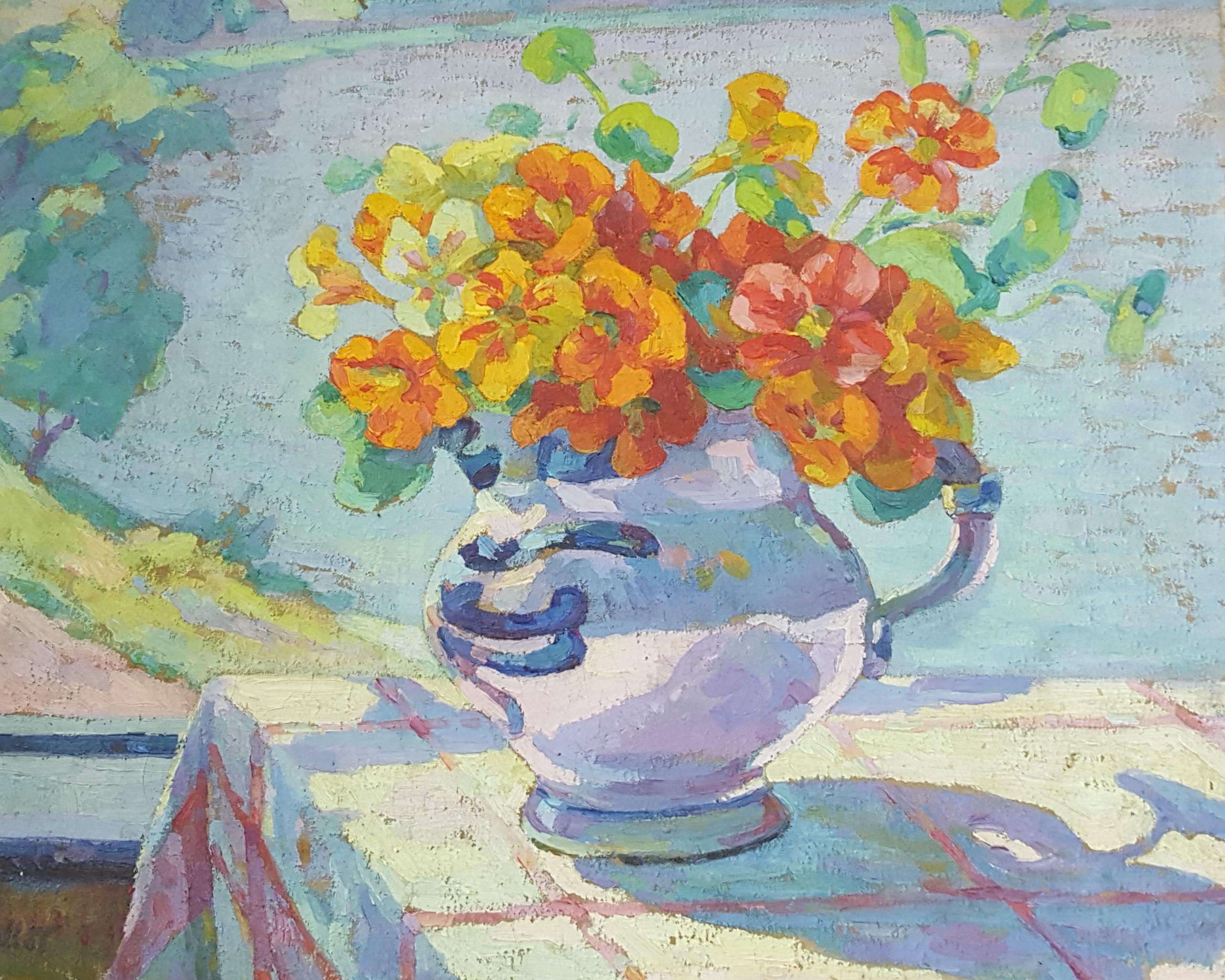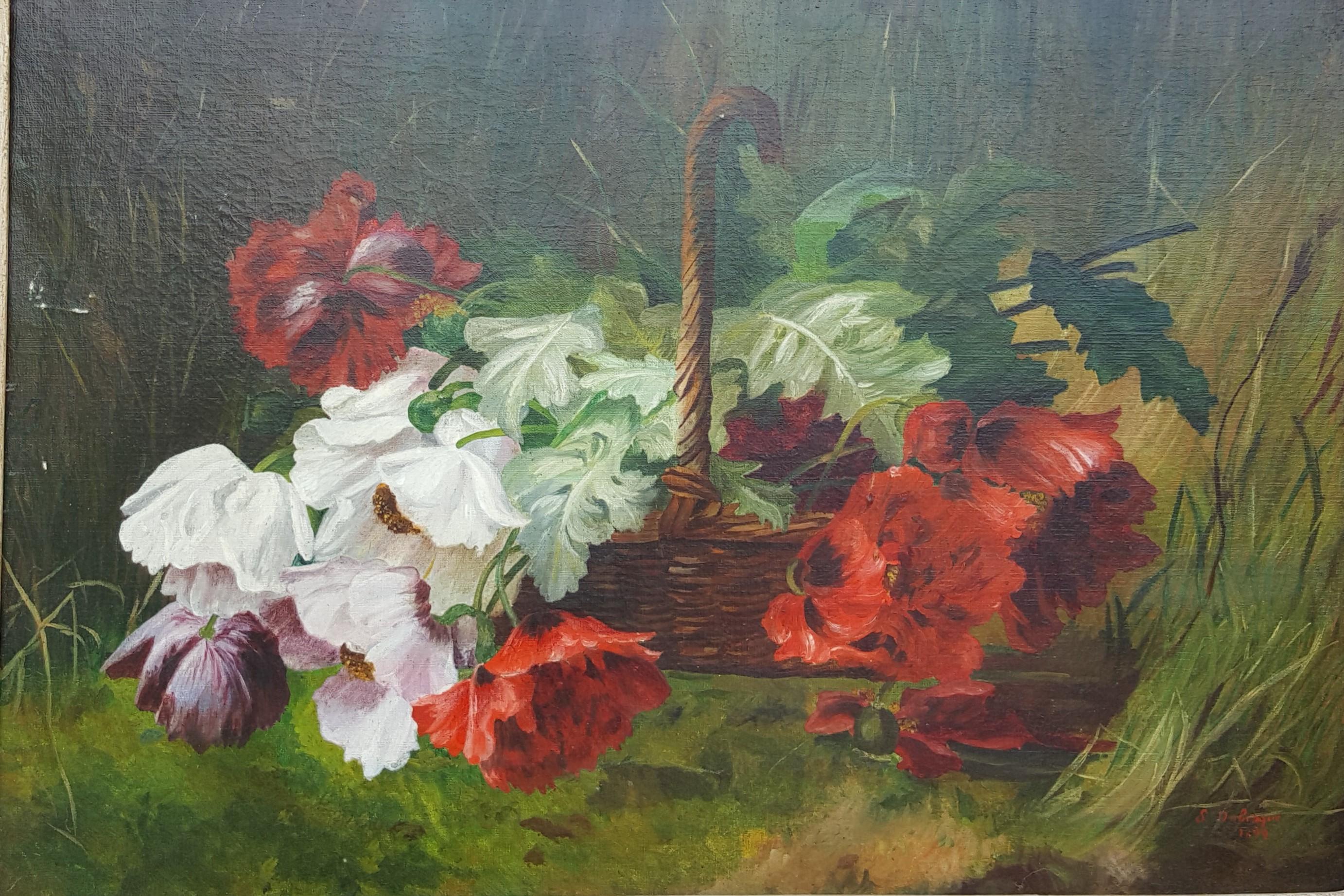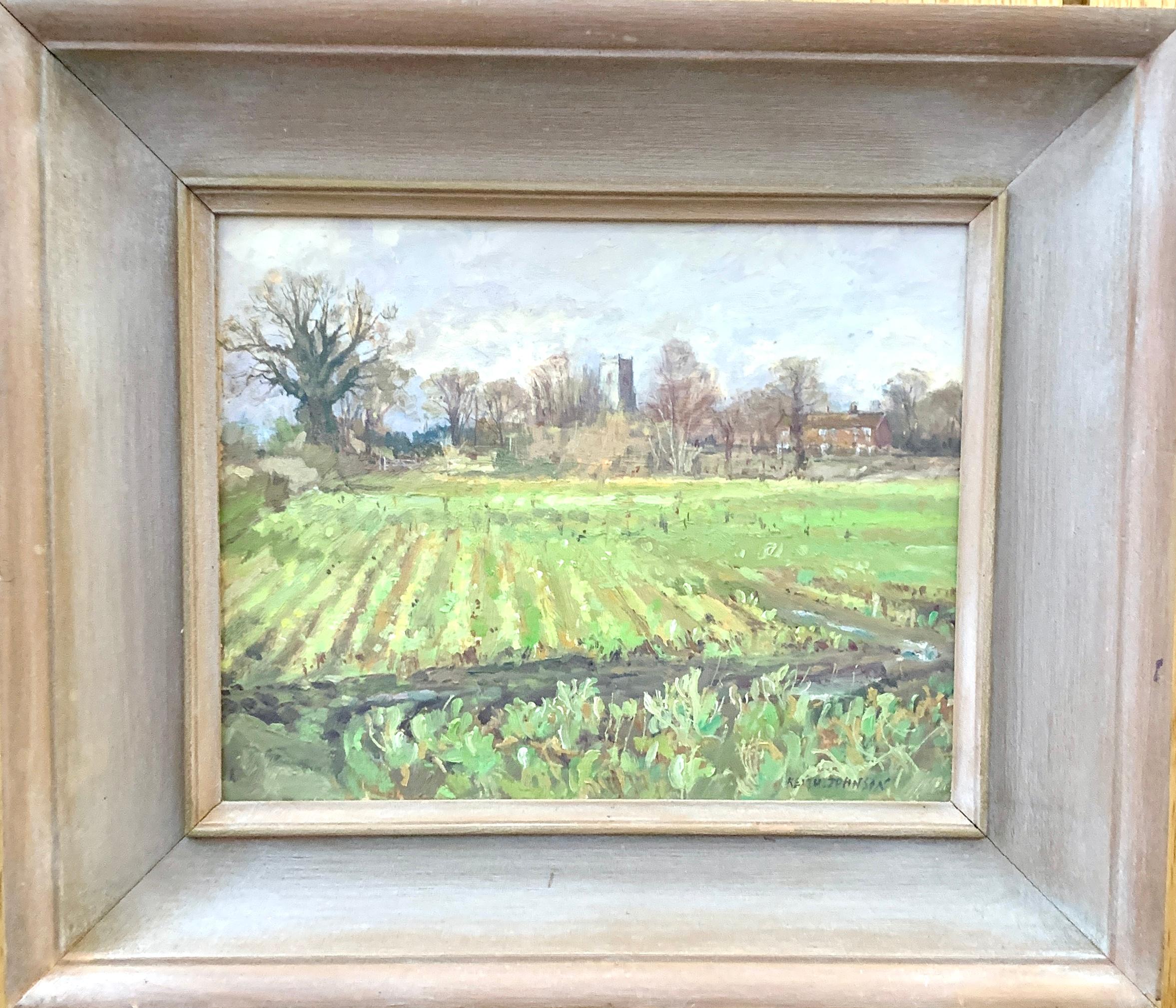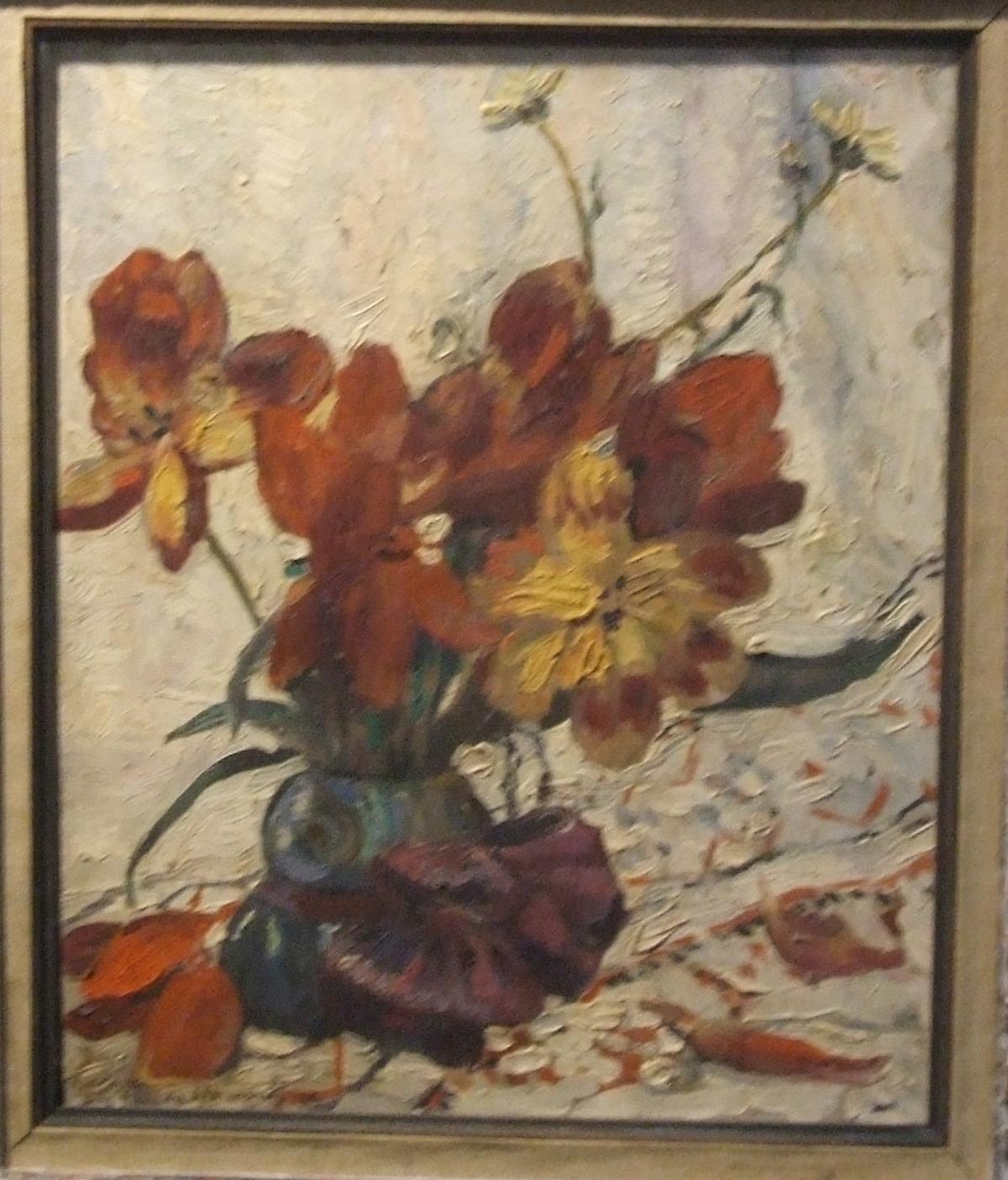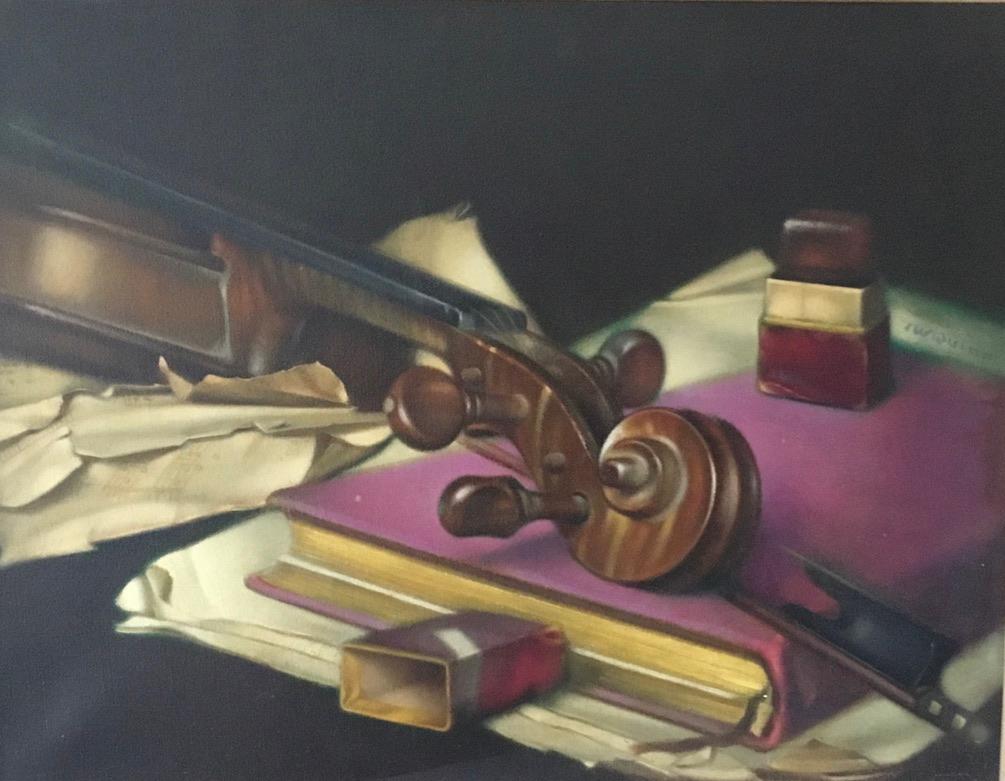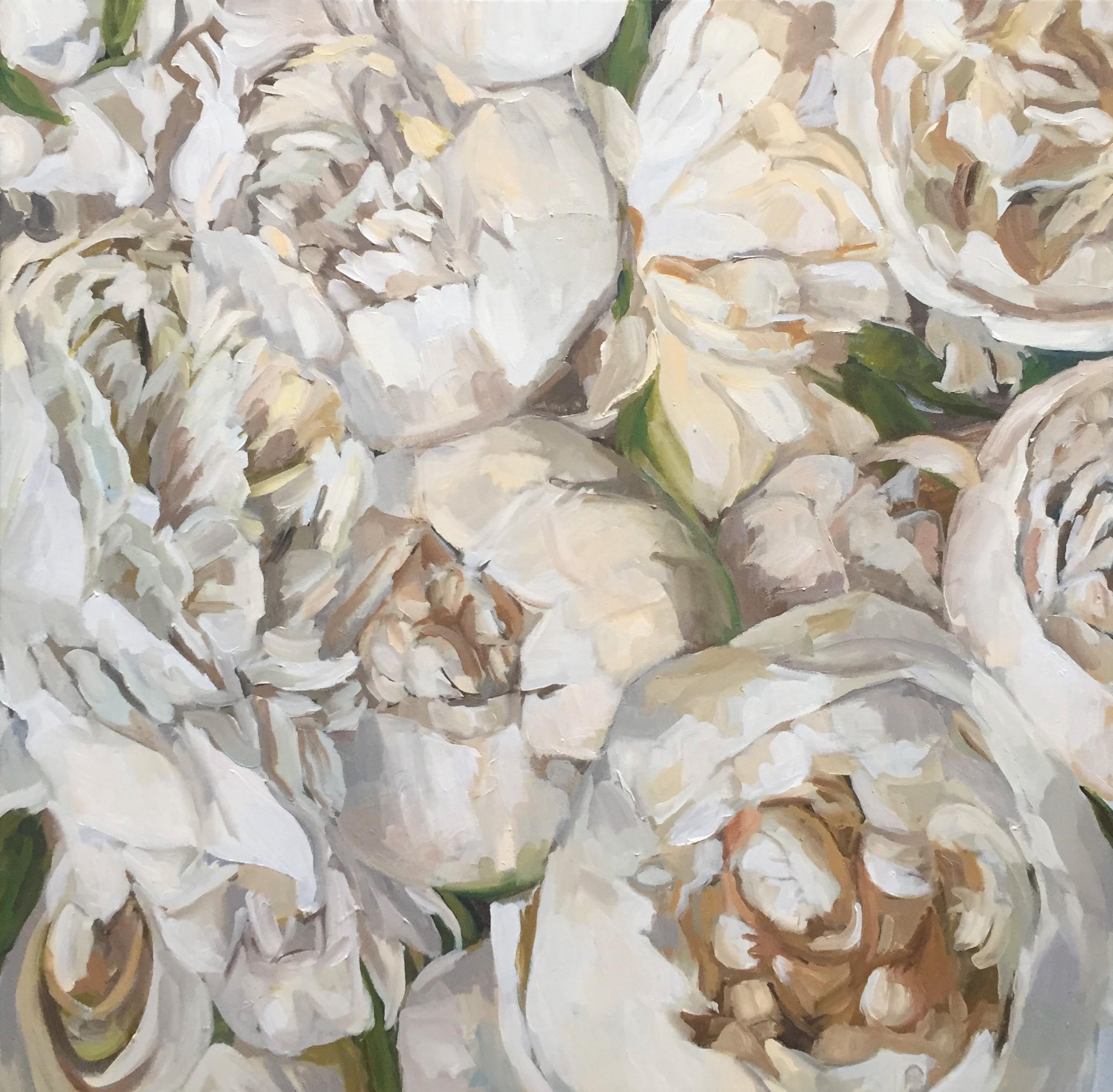Items Similar to A Still Life of Figs and Melon
Want more images or videos?
Request additional images or videos from the seller
1 of 10
Jean-Baptiste Joseph OliveA Still Life of Figs and Melonc.1880
c.1880
About the Item
Jean Baptiste Olive
This premiere piece shows his work and influence which he had with Antoine Vollon. It is in its museum quality gold leaf frame. The piece has been exhibited in many shows with the exhibition labels on the reverse testimony.
Artwork Size: 22 x 18" (56 x 46cm)
Artwork Size with Frame: 31 x 27" (79 x 69cm)
Free Shipping
French, 1848-1936
Jean-Baptiste Olive was undoubtedly one of the greatest masters of the Marseille school at the end of the 19th century, along with Paul Guigou and Adolphe Monticelli. The landscapes of Provence provided him with most of his subjects for seascapes and harbor views, but Olive also left us some beautiful still lifes. Thick subject matter, impressionistic lighting effects, and skillful staging characterize the art of this luminous painter, many of whose works are preserved in major museums.
Olive, the son of a wine merchant, was born in Marseille’s Saint-Martin neighbourhood. Étienne Cornellier, a decorator, encouraged him to register at École des beaux-arts de Marseille where he studied under the guidance of Joanny Rave. There he received several awards including, in 1871, the live model class’s first prize. While training as a decorator, he painted many scenes of Marseille, its Vieux-Port, its islands, and its seashore. In 1874 he travelled to Italy, mainly to Genoa and Venice. He occasionally participated in some of Provence’s exhibitions at the time.
In 1882 he relocated to Paris. He began his classical apprenticeship in the studio of Antoine Vollon where he learned to render the realism of still life. Whilst in Paris he contributed to the decoration of Cirque d’Hiver, Basilica of the Sacré Cœur and Exposition Universelle de 1889 (he was awarded a silver medal for the latter). From 1874 onward he exhibited repeatedly at Salon de Paris and was awarded several prizes there. In 1881 he became a member of Société des Artistes Français.
The painter lived between the capital and Marseille where he kept a studio on the Canebière. At the 1886 Salon, Jean Baptiste Olive won a medal for a landscape of Marseille. This marked the beginning of a great recognition of his painting marked by the bright light of the sun. In 1889, he executed decorations for the pavilions of the World Fair.
In 1900 he won an order by the company Chemins de fer de Paris à Lyon et à la Méditerranée for two paintings created as decoration for the Golden Room at Le Train Bleu (restaurant) designed by architect Marius Toudoire in the Paris-Gare de Lyon train station (both paintings can still be seen there).
In 1930, aged 82, he was awarded the Léon Bonnat prize.
In addition to Étienne Cornellier, his friends were painters Gustave Marius Jullien (1825-1881), Antoine Vollon, Robert Mols, Raymond Allègre and Théophile Décanis.
He was supported by several patrons, among them General Malesherbes and Marie-Louis Gassier, the owner of company Berger, a producer of pastis. In 1948, twelve years after his death, Marseille’s Musée Cantini dedicated an exhibition to his centenary, displaying eighty-two of his paintings.
- Creator:Jean-Baptiste Joseph Olive (1848 - 1936, French)
- Creation Year:c.1880
- Dimensions:Height: 31 in (78.74 cm)Width: 27 in (68.58 cm)Depth: 4 in (10.16 cm)
- Medium:
- Movement & Style:
- Period:
- Condition:Very good condition with exhibition labels on the reverse of the frame.
- Gallery Location:St. Albans, GB
- Reference Number:1stDibs: LU2469212197432
About the Seller
5.0
Gold Seller
These expertly vetted sellers are highly rated and consistently exceed customer expectations.
Established in 1965
1stDibs seller since 2023
19 sales on 1stDibs
Typical response time: 1 hour
- ShippingRetrieving quote...Ships From: St. Albans, United Kingdom
- Return PolicyA return for this item may be initiated within 7 days of delivery.
More From This SellerView All
- Un Bouquet de Fleurs SpectaculaireBy Marcel DyfLocated in St. Albans, GBMarcel DYF 1899 - 1985 Oil on canvas Canvas Size 28 x 23" (72 x 60cm) Outside Frame Size: 36 x 31" (92 x 80cm) Free Shipping Dyf’s family lived in Paris, but he spent his childhood holidays in Normandy at Ault, Deauville, and Trouville. The artistic climate to which he was exposed in Paris and in Normandy was crucial during his youth, as innovative ideas and new thinking, born of the Impressionist and Post-Impressionist movements, formed ever widening circles of influence in Europe. Swept up in the atmosphere, Dyf decided in his early twenties to give up his career in engineering and become an artist. He moved to Arles in 1922 to pursue his calling and he kept a studio there until 1942. He had little formal artistic training but owed much of his inspiration to the great masters of the past such as Rembrandt, whom he particularly admired, Vermeer and Tiepolo. In Provence, challenged by a new range of colours and light, by new landscapes and images and under the same intense sky that lent its brilliance to Van Gogh’s art, Dyf graduated from painter to artist. Whilst living in Arles, Dyf was commissioned to paint a number of large historical and decorative works, mostly frescoes, in the town halls of Saint Martin-de-Crau and Les Saintes Maries-de-la-Mer, in Arles, in the Museon Arlaten and in the dining hall of the Collège Ampère. He also designed windows for the church of Saint Louis in Marseille. In 1935 Dyf took on Maximilien Luce’s old studio in the Avenue du Maine on the left bank. His partial return to Paris meant that he could work with many whose names became renowned for their highly original contributions to art, music, and literature. Paris hummed with creative vitality in the 1930s and Dyf was both participant and recipient in the atmosphere. Paris was shattered by the invasion of 1940. Like many others, Dyf left the city and returned to Arles, but he quickly had to abandon his home in the south and he took to the Maquis, entering the Résistance in Corrèze and the Dordogne. After the Liberation he returned to Arles to find the studio reduced to rubble in the fighting. He retreated, heavy-hearted, to Paris but the pull of the Midi was deep-rooted, so in time he returned and made a new base in Saint Paul-de-Vence. Thereafter he divided his time between Paris and the south. His pictures began to sell through galleries in Cannes, Nice, Marseille and Strasbourg. In Paris he exhibited and sold his paintings through the Salon d’Automne, the Salon des Tuileries and the Salon des Artistes Français. In the first half of the 50s Dyf worked in Paris throughout the winter and spent the summer in Cannes, where he set up a studio-gallery and established a regular following among American visitors to the Riviera. In 1955 the first paintings were bought from Dyf by Frost & Reed to be sold in London, thus heralding the formation of a remarkable and enduring relationship between artist and gallery. In the summer of 1954, Dyf met Claudine Godat. Aged 19, she was thirty-six years younger than Dyf and with her long fair hair, clear skin, vivacity and patience, she was what the artist felt to be his perfect model. It was simply love at first sight. There was an instant rapport between them and her arrival in his life acted as a catalyst, bringing Dyf’s art forward to the threshold of its most mature phase. In 1956, they married and bought a 16th century hunting lodge at Bois d’Arcy, near Versailles. This became their main home, but each winter they returned to Provence on painting trips, staying in Saint-Rémy or in the small village of Eygalières. The olive trees, the cane windbreaks and the grey-white crags of the Alpilles provided countless motifs for Dyf’s paintings of Provence, and his artistic and emotional attachment to the area endured to the end of his life. In 1960, at Claudine’s insistence, they first visited Brittany. They explored widely and finally came upon the Golfe du Morbihan. Dyf was enchanted with this remote, beautiful region. He immediately saw the potential for new subjects, in the still waters of the huge lagoon surrounded by rolling fields of wheat and tiny clusters of slate-roofed cottages, and he knew he must return to paint there. From that time on the seasons of the year followed the same pattern: autumn was spent at home near Versailles and in the late autumn or early spring Dyf and Claudine drove south and spent six or eight weeks in Provence. In May they left for Brittany, where they spent the summer in a house they had bought opposite the church in the village of Arzon. Two or three times a year Frost & Reed would visit Dyf and buy all the best of his works for their stock. Dyf could never work in an empty studio, he said that it deadens an artist’s inspiration, so immediately the paintings had left for London, he and Claudine would set off to the west or to the south in search of new inspiration. This annual round having been established, there followed many years of great fulfilment. The artist, free from the burden of running the more mundane side of his life, was now able to devote all his time to painting and through Frost & Reed, his sole world agent, he was guaranteed an outlet for his work. To watch Dyf paint was entrancing. Even as an old man, he would stand rather than sit before the easel, working with extraordinary vigour and intense concentration. His palette was a rainbow of fresh colours and his hand continually darted back and forth from the canvas. At intervals he would step back or consider briefly another picture before returning to the easel, his eye refreshed. Usually he sketched straight onto the canvas, which he set up on his travelling easel...Category
1960s Impressionist Still-life Paintings
MaterialsOil
- A Still Life of Roses in a Ceramic Vase. An oil on canvasBy Marcel DyfLocated in St. Albans, GBMarcel DYF 1899 - 1985 This piece has been confirmed by Claudine Dyf Picture Size: 18 x 22" (48 x 55cm) Outside Frame Size: 25 x 29" (63 x 73cm) A highly desirable still life with...Category
Mid-20th Century Impressionist Still-life Paintings
MaterialsOil
- A Still Life of BegoniasBy James Stuart ParkLocated in St. Albans, GBJames Stuart Park Scottish School Oil Canvas Picture Size: 30 x 24" (76 x 60cm) Outside Frame Size: 40 x 34" (102 x 86cm) Park lived from 1862 – 1933 and was born in Kidderminst...Category
Early 20th Century Impressionist Paintings
MaterialsOil
- A Still Life of RosesLocated in St. Albans, GBKees TERLOW/ TERLOUW Panel Size: 24 x 48" (61 x 122cm) Outside Frame Size: 30 x 54" (76 x 137cm) Oil on panel A signature style piece with bold, beautifully painted roses and his ...Category
Early 20th Century Impressionist Still-life Paintings
MaterialsOil
- A Still Life of the Madonna, Flowers and a China PotLocated in St. Albans, GBHenri Lucien Joseph BURON This is potentially Henri Buron's premier work of art. It was exhibited in the Salon des Artistes Française in 1934 having been painted in 1933. The revers...Category
1930s Impressionist Still-life Paintings
MaterialsOil
- A Still Life of FlowersBy Dorothea SharpLocated in St. Albans, GBA wonderful example of Dorothea Sharp's still lifes. Full of vibrancy and effervescence this painting ,with her classic broad brush strokes, show her talent at its best. It is in a w...Category
Early 20th Century Impressionist Still-life Paintings
MaterialsOil
You May Also Like
- Primrose BouquetLocated in Pasadena, CAOil on canvas not framed representing a bouquet of primroses in the style of the fawn impressionist painter. The painting is signedCategory
1920s Impressionist Figurative Paintings
MaterialsOil
- Red Flower BasketLocated in Pasadena, CAOil on canvas representing a flower basket in the style of the Impressionnisme school of the 19th century signedCategory
Early 20th Century Impressionist Figurative Paintings
MaterialsOil
- Impressionist English Landscape scene of a Norfolk church near Frettenham.Located in Woodbury, CTImpressionist English 20th century Landscape scene of a Norfolk church near Frettenham. Keith Arthur Johnson was born at South Pickenham, Swaffh...Category
1970s Impressionist Still-life Paintings
MaterialsOil
- Nature morte, 1918 - Huile sur toile, 46x38 cm., encadréBy Alexandre AltmannLocated in Nice, FRHuile sur toile par Alexandre Altmann. Avec cadre: 68x61 cm Alexandre Altmann, né à Kiev (Ukraine) en 1878 et mort en France en 1932, est un peintre russo-français de l'École de Paris, connu notamment pour son tableau L’inondation de Paris. Alexandre Altmann fait ses études aux Beaux-Arts d’Odessa1. Il quitte Odessa en 1905 pour Paris, où il trouve un atelier à la Ruche. Il fait alors la connaissance d'Emile Schuffenecker. En 1910, Altmann connaît une certaine notoriété à la suite de l’exposition de son tableau L’inondation de Paris. En 1912, la Galerie Devambez lui consacre une grande exposition. En 1920, il s'installe à Nemours. Il séjourne souvent à Saint-Jean-de-Luz, au Pays Basque, en compagnie de son ami le jeune artiste...Category
1910s Impressionist Still-life Paintings
MaterialsOil, Canvas
- STILL LIFE WITH STRADIVARIUS T W QUINN BRITISH ARTISTBy TOMAS WILLIAM QUINNLocated in Pollenca, Illes BalearesBorn of Irish parents in 1918, Tom W. Quinn has quite simply dedicated his life to art. A life dedicated to art? Yes, and a heart and soul, too. As this exhibition opens he will have...Category
21st Century and Contemporary Impressionist Still-life Paintings
MaterialsOil
- White Peonies from Covent GardenBy Katharine RoweLocated in London, GBThis was the flower artist Katherine Rowe had in her wedding bouquet and so they have always had a special place in my heart. Despite being 'white' there is hardly any actual pure white in the painting but multiple blues and yellows and greens. Katharine Rowe is an English painter she graduated in Fine Art and History of Art at the University of Edinburgh in 1999 and spent a year studying at Université de la Sorbonne, Paris. Having spent a decade working in advertising Katharine felt the increasing need to be out of the office and with her paintbrush. The past 9 years have been dedicated to just that. Katharine is strongly motivated by colour and she often spends up to an hour mixing and preparing paints before turning to the canvas. Katharine is always inspired by her surroundings from the varied landscapes of...Category
2010s Impressionist Still-life Paintings
MaterialsOil
Recently Viewed
View AllMore Ways To Browse
Antique Stills
19th Century French Still Life
Death Of Major
Antique Italian Still Life
French Still Life Paintings 19th Century
Fig Art
Antique Italian Still Life Painting
Saint Jean Paul
Wine Still Life Painting
Still Life Painting With Wine
19th Century Impressionist Still Life
Figs Paintings
19th Century French Oil Still Life Painting
Paintings 19th Century Room In Paris
Fig Gold
Italian Fig
Olive Leaf
Antique Olive Paint
